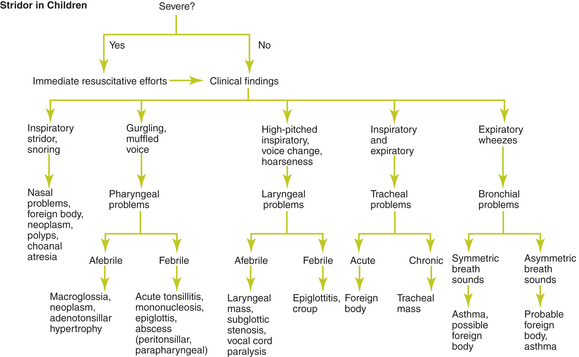Chapter 42 STRIDOR
General Discussion
Anatomically, stridor is a phenomenon caused by narrowing of the upper airway. The upper airway may be divided into supraglottic, glottic and subglottic, and intrathoracic areas. These anatomic distinctions are essential in targeting the possible causes of stridor (Figure 42-1). The supraglottic area includes the nasopharynx, epiglottis, larynx, aryepiglottic folds, and false vocal cords. The glottic and subglottic area extends from the vocal cords to the extrathoracic portion of the trachea.

Figure 42-1 Algorithm, based on clinical findings, for evaluating stridor in children.
(Adapted with permission from Handler SD. Stridor. In: Fleisher GR, Ludwig S, eds. Textbook of Pediatric Emergency Medicine. Baltimore: Williams & Wilkins; 1993:474–478.)
If a bacterial cause is suspected, rapid and decisive action must be taken.
Causes of Stridor
Supraglottic area
• Gastroesophageal reflux disease
• Hypertrophic tonsils and adenoids
• Intubation (resulting in vocal cord paralysis, laryngotracheal stenosis, subglottic edema, or laryngospasm)
• Laryngospasm (hypocalcemic tetany)
Glottic and Subglottic Area
• External compression of the trachea






